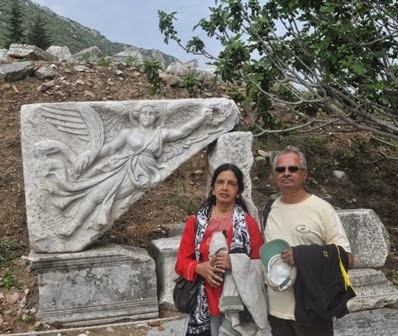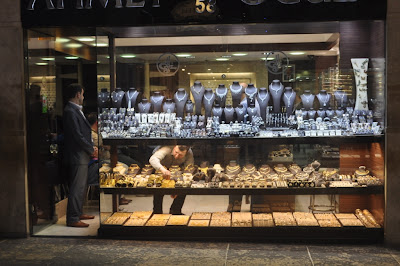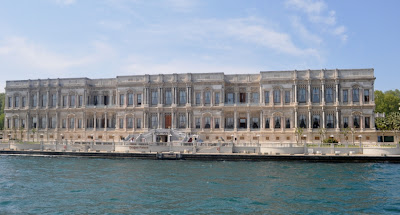CAPPADOCIA
On completion of our
sightseeing, we left Ankara after lunch on 6th May, for Cappadocia which
is about 4 hours drive from Ankara.
Cappadocia
is something unbelievable. Would you believe that people have carved out homes,
stores, shops and even star hotels out of rocks? We could not get accommodation
in a cave hotel and had to be contented with having lunch in one of them. Hot
air ballooning is very popular. One can get a fantastic view of the entire
Cappodocia in an hour’s journey. The cost however is very high $ 125 per head.
The area is a popular
tourist destination, as it has many areas with unique geological, historic, and
cultural features.
The most important towns and
destinations in Cappadocia are Urgup, Goreme, Ihlara Valley. Among the
underground cities worth seeing are Derinkuyu, Kaymakli,. The best historic
mansions and cave houses for tourist stays are in Urgup, Goreme.
Cappadocia contains several underground cities largely used by early Christians as hiding places before Christianity became
an accepted religion.
Underground Cities? These cave-cities were excavated as early as
Hittite times, and expanded over the centuries as various marauding armies
traversed Central Anatolia in search of captives and plunder. There are 36
underground cities in Cappadocia and the largest one is Kaymakli
underground city.
The guides keep warning
that those with breathing problems or suffer from claustrophobia or pains in
the legs especially knees should avoid getting into the underground city. There
is only one entrance and there is no way to turn back. Once you enter you have
to go the entire length and come out from the exit. Even though I am otherwise
physically fit, I am slightly claustrophobic and was hesitant. But with my
wife’s prodding and due to the importance of the place I decided to take the plunge.
I did not expect what I
saw. The corridors are so narrow only a normal person can pass through. They
are also steeply sloping. One has to bend at your waist and walk quite a
distance and suddenly you are in a large room where you can stand erect, breath
and enjoy. Ventilation through the shafts is very good. If you are part of a
slow moving group you had it. You go down for four floors, stop at various
places while the guides explains about it and then keep moving up till you come
out at ground level. The trip took nearly 55 minutes. It is simply massive
network and unimaginable unless you experience it. Even though it was a great
experience it was a greater relief when you walk into open ground, breathe
fresh air and have a cup of fresh Turkish coffee or tea from the nearby shop.
Kaymaklı Underground City
This is contained within the citadel of
Kaymaklı in the Central Anatolia region of Turkey. Kaymakli is about 19 km from Nevşehir,.
The houses in the village are constructed around the nearly one hundred tunnels
of the underground city. The tunnels are still used today as storage areas,
stables, and cellars. The tunnels are low, narrow and steeply inclined.
While the underground city consists of 8 floors below
ground, only 4 of them are open to the public today, in which the spaces are
organized around ventilation shafts. Of the four floors open to tourists,
each space is organized around ventilation shafts. This makes the design of each
room or open space dependent on the availability of ventilation. The ventilation shaft can also
be seen from the 4th floor. It is a vertical well and passes all floors down
like on the elevator in an apartment. The depth of the ventilation shaft is about
80 meters in total.
A stable
is located on the first floor. The small size of the stable could indicate that
other stables exist in the sections not yet opened. To the left of the stable
is a passage with a millstone door. The door leads into a church. To the right
of the stables are rooms, possibly living spaces.
Located on
the second floor is a church with a nave and two apses. Located in front of the apses is a baptismal font,
and on the sides along the walls are seating platforms. Names of people
contained in graves here coincide with those located next to the church, which
supports the idea that these graves belonged to religious people. The church
level also contains some living spaces.
The third
floor contains the most important areas of the underground compound: storage
places, wine or oil presses, and kitchens. The level also contains a remarkable
block of andesite with relief textures. Recently it was
shown that this stone was used as a pot to melt copper. The stone was hewn from
an andesite layer within the complex. In order for it to be used in metallurgy,
fifty-seven holes were carved into the stone. The technique was to put copper
ore into each of the holes about 10 centimetres
in diameter and then to hammer the ore into place. The copper was
probably mined between Aksaray and Nevsehir.
(Photos 7 and 8 of Underground City)
The high
number of storage rooms and areas for earthenware jars on the fourth floor
indicates some economic stability. Kaymaklı is one of the largest underground
settlements in the region. The large area reserved for storage in such a
limited area appears to indicate the need to support a large population
underground. Currently only a fraction of the complex is open to the public and
it is said approximately 5000 people lived in the area.
The underground cities have vast defence
networks of traps throughout their many levels. These traps are very creative,
including such devices as large round stones to block doors and holes in the
ceiling through which the defenders may drop spears. These defense systems were
mainly used against the Romans. The tunnel system also was made to have narrow
corridors as the Roman fighting strategy was to move in groups, which was not
possible to in these narrow corridors.
Thousands of years ago when
Erciyes Mountain was active, the lava that was cast forth covered an area approximately
20,000 sq.km. Afterwards, when it became an inactive volcano, this region
encountered a tremendous wind and water erosion for hundreds of years.
As a result of this erosion, the soil was
abraded and dragged away and the rocks which were able to withstand this
abrasion were left uncovered. The small rock pieces that are hard remained on
top of the larger rocks and formed the fairy chimneys of
today. (Please see the
attached photos)
The Christians who took
shelter in the Goreme valley because of the Arab pressures gave it the name of
Goreme which means "you cannot see here".
The village of Göreme is an
unsurpassed example of the harmony of man and nature. . People of Göreme, at
the heart of the Cappadocia Region, realized that these soft rocks could be
easily carved out to form houses, churches, monasteries. People still live in
the rock houses or use them as storerooms today, displaying an immense
reverence for this volcanic earth and history. The village of Göreme does not
only have rock houses, but also rock restaurants and rock hotels which all
visitors find amazing and the fairy chimneys. It's a place that offers
unbelievable natural treasures.
The Goreme Open-Air Museum resembles a vast monastic complex composed of
scores of monasteries placed side-by-side, each with its own fantastic church. . It contains the
finest of the rock-cut churches, with beautiful frescoes (wall paintings) whose colors still retain
all their original freshness. It also presents unique examples of rock hewn
architecture and fresco technique. The Goreme Open Air Museum has been a member
of UNESCO World Heritage List since 1984, and was one of the first two
UNESCO sites in Turkey.























































































